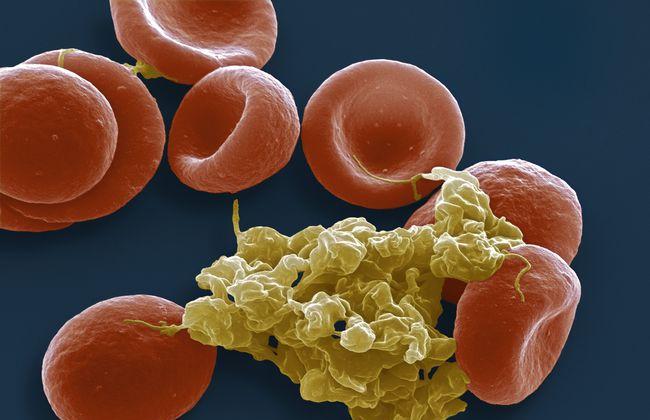Platelet Concentrates – Comparable in Quality and Stability
Blood platelet concentrates are indispensable in transfusion medicine, especially in the treatment of cancer diseases and serious bleeding events. In Germany, they are produced as single concentrates by means of apheresis or from multiple whole-blood donations. Researchers of the Paul-Ehrlich-Institut (PEI) have now studied both concentrate types in the laboratory and have demonstrated that their parameters are comparable with regard to function and stability. Thus, platelet concentrates of high quality are available in Germany, independently of their manufacturing procedure. Transfusion Medicine and Hemotherapy reports on the results in its online version of 10.01.2020.

Platelets play a key role in the coagulation of blood and are thus unique and indispensable as medicines in transfusion medicine.
With up to five days, the stability of these products is short, which is why the provision of platelet concentrates in sufficient quality and high quantity presents a major challenge for blood donation centres.
In Germany, platelet concentrates are produced by means of two different manufacturing procedures:
- By means of the so-called platelet apheresis, during which the concentrate is produced by a machine from a single donation. During this process, the platelets are removed from the donor’s blood, and the remaining blood is re-infused into the donor’s bloodstream.
- By production from multiple wholeblood donations. This procedure involves isolation of platelets from individual donations and subsequent pooling into a concentrate.
In Germany, both apheresis platelet concentrates and pool platelet concentrates are authorised for transfusion. Professional circles are discussing in detail to what extent both types of concentrates can be considered as equivalent with regard to their quality and functionality.
Scientists from Dr Ursula Salge-Bartels’s team of Division Haematology/Transfusion Medicine at the Paul-Ehrlich-Institut (PEI) have devoted themselves to the quality and stability of platelet concentrates supported by the Federal German Ministry of Health (BMG), and, in an extensive study, they have compared the in vitro functionality of both concentrate types.
In this study, the researchers examined platelet concentrates at different points of time after their production, and recorded innovative in vitro functional and stability parameters. They studied the morphology of the platelets by means of transmission electron microscopy. Previous studies reported on the effects of shear forces on the activation of platelets. These partly lead to a loss in the reactivity, which is a physiologically essential function of the platelets for the coagulation course. To what extent the manufacturing procedure plays a role for possible losses in the function of thrombocytes remains as yet to be examined. For this reason, the PEI research team established a suitable test system to compare the effects of shear forces, such as those that can occur in the human capillary system, for platelets which were produced from both manufacturing procedures.
By means of the comprehensive spectrum of analytic methods, the researchers established that the morphology as well as the in vitro function and stability parameters were comparable for the platelets studied. This points to the fact that platelet concentrates of high quality are available in Germany, independently from the manufacturing procedure.
However, some platelet concentrates showed a high variability in some parameters, no matter whether the products concerned were pool or apheresis concentrates.
"We intend to conduct further studies to clarify the reasons for the variability observed in individual products,"
explained Dr Salge-Bartels. What is also of note is whether other innovative manufacturing procedures will result in platelet concentrates which show comparable in vitro functional and stability parameters.
Original Publication
Fiedler SA, Boller K, Junker AC, Kamp C, Hilger A, Schwarz W, Seitz R, Salge-Bartels U (2020): Evaluation of the in vitro function of platelet concentrates from pooled buffy coats or apheresis.
Transfus Med Hemother 47: 314-324.
Text
top



